Top 10 Lean Canvas Examples
Jun 25, 2024 • 11 min read
Lean Canvas Definition
The Lean Canvas is a streamlined, one-page business model template designed by Ash Maurya to evolve the Business Model Canvas. It is beneficial for startups and new product ideas. It offers a quicker and more efficient method of explaining and testing business concepts. Traditional business plans can be complex and quickly become outdated.
The Lean Canvas breaks down a business idea into its core assumptions. It creates a high-level sketch that evolves as you gain more insights. The Lean Canvas comprises nine elements that capture the essence of a business idea:
- Customer Segments
- Customer Problem
- Unique Value Proposition
- Solution
- Unfair Advantage
- Traction Channels
- Revenue Streams
- Cost Structure
- Key Metrics
Each element is filled out in a specific order. You start with understanding the customers and their problems, moving to value creation and solution design. Finally, you will focus on revenue, cost, and metrics.
The structured approach of Lean Canvas helps startups and product teams create a cohesive and persuasive lean business plan. Communicating such a plan with investors and team members is easy, as it ensures alignment and clarity in pursuing strategic goals. Check out our comprehensive blog post for more information on Lean Canvas.
10 Examples of Lean Canvas
1. Google
Founded: 1998
Created by: Larry Page and Sergey Brin
Headquarters: Mountain View, California, USA
Total funding: Approximately $36.1 million (before IPO)
IPO: $1.67 billion in 2004
Stock ticker: GOOGL (Class A), GOOG (Class C)
Google is the typical garage startup created by two PhD students that turned into a giant corporation. They focused on solving the problem of web users' poor search experience at the time. Directories where curators manually built catalogs with websites were booming because of this.
They created a new search engine that offered orders of magnitude better experience by focusing on the indexing algorithm. Instead of looking for matching strings to prioritize the search results, they added new factors such as how many links point to a given resource. This, in turn, accounted for the credibility and authority of the resource.
One key product metric measures how many users find the relevant answer to their query on the first page. Improving this metric alone leads to happy users who come back and tell their friends about the service.
Let’s take a look at the filled in Lean Canvas for Google if we had to go back in time.
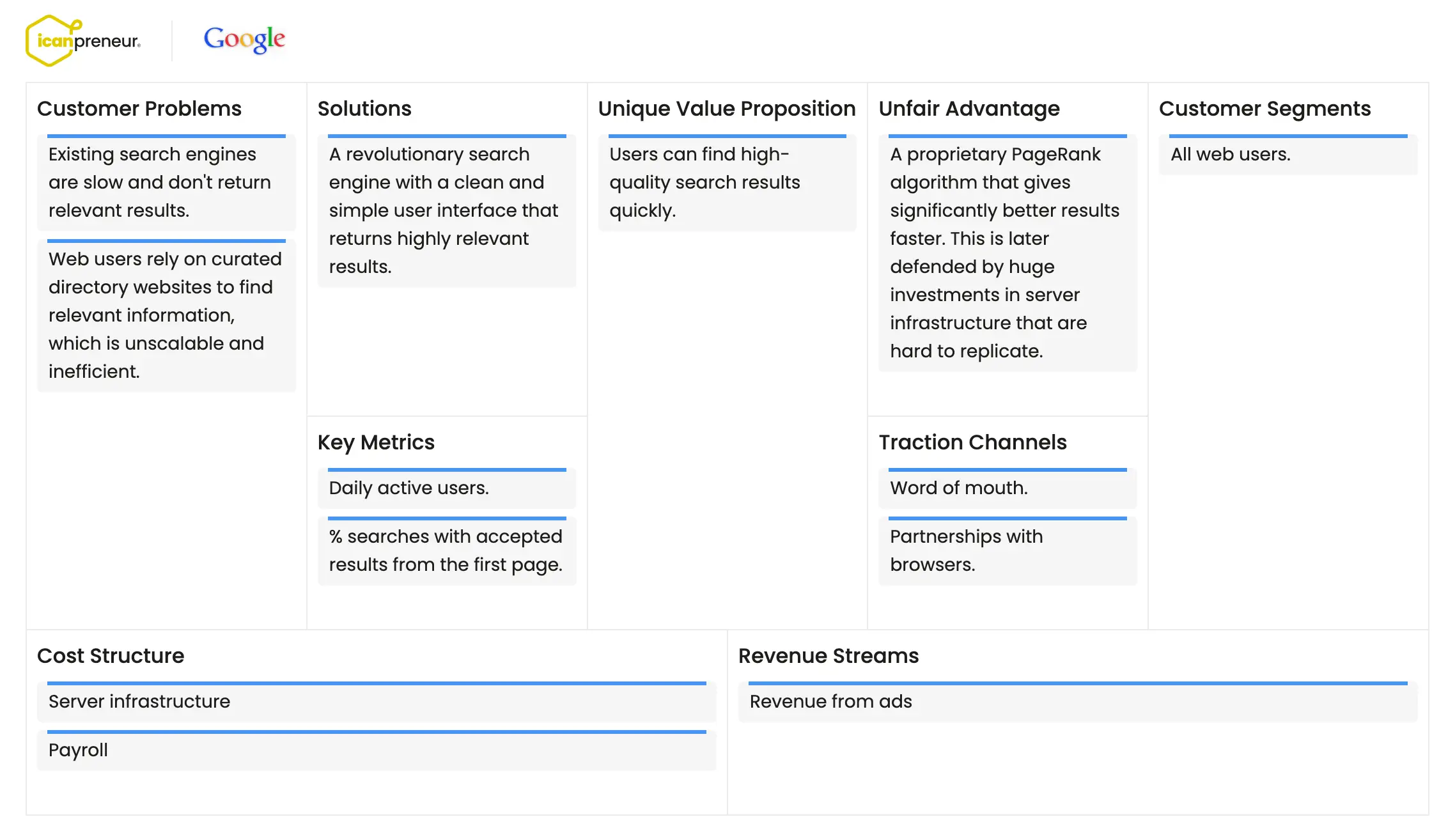
2. Youtube
Founded: 2005
Created by: Steve Chen, Chad Hurley, and Jawed Karim
Headquarters: San Bruno, California, USA
Total funding: $11.5 million (before acquisition)
IPO: N/A (acquired by Google for $1.65 billion in 2006)
Stock ticker: N/A (part of Google, stock tickers GOOGL and GOOG)
At the time of YouTube’s launch - there were no major video-sharing platforms. Apple will announce the first iPhone two years later, and amateurs created videos mainly with their cameras and webcams. Sharing and consuming videos was difficult due to the internet being expensive and having limited bandwidth.
The founders of YouTube decided to create a platform on which everyone could upload videos with a few clicks and other people could watch it almost immediately. After its initial success, Google acquired the company and YouTube became one of the main pillars in their ads strategy. Currently, around 10% of Google's ad revenue comes from YouTube, which accounts for more than $30 billion per year.
This is how Youtube's Lean Canvas could look like back in 2005:
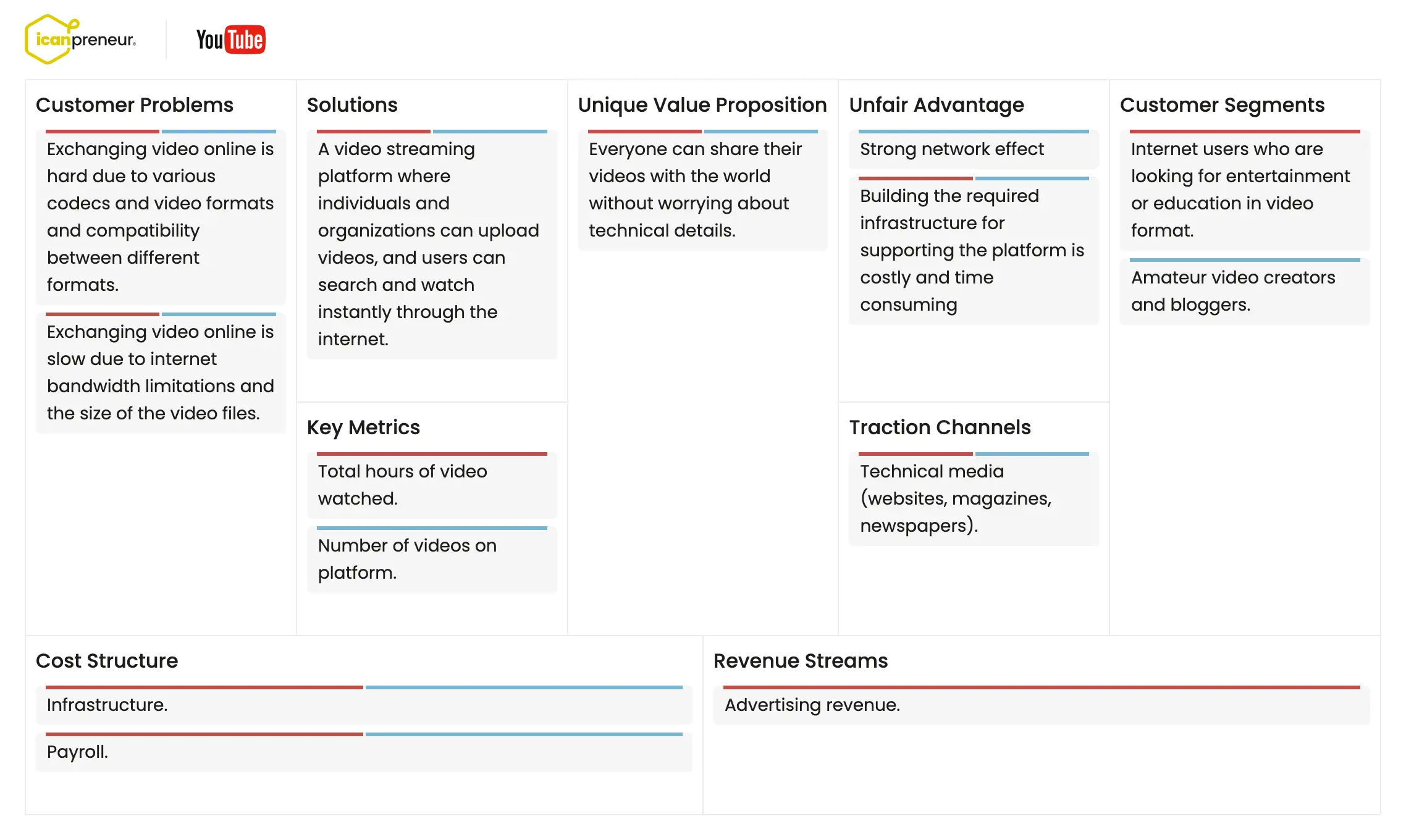
3. Airbnb
Founded: 2008
Created by: Brian Chesky, Joe Gebbia, and Nathan Blecharczyk
Headquarters: San Francisco, California, USA
Total funding: Approximately $6.4 billion (before IPO)
IPO: $3.5 billion in 2020
Stock ticker: ABNB
Airbnb is an excellent example of the sharing economy. It creates a new market by allowing small property owners to rent their free property in the short term. At the same time, it offers travelers unique places to stay, a home-like atmosphere, and a personal touch provided by their hosts.
Often, it’s very hard to spin off a marketplace-type service. It needs a critical mass of users both on the supply side (hosts) and the consumer side (guests). In this case, Airbnb really embraced the concept of the minimum viable product by starting small. Their MVP was offering airbeds in their spare room. Once the team got validation for their product, the rest is history—Airbnb is now more significant than the biggest hotel chains in the world.
This is how the Airbnb Lean Canvas would have looked back in 2008.
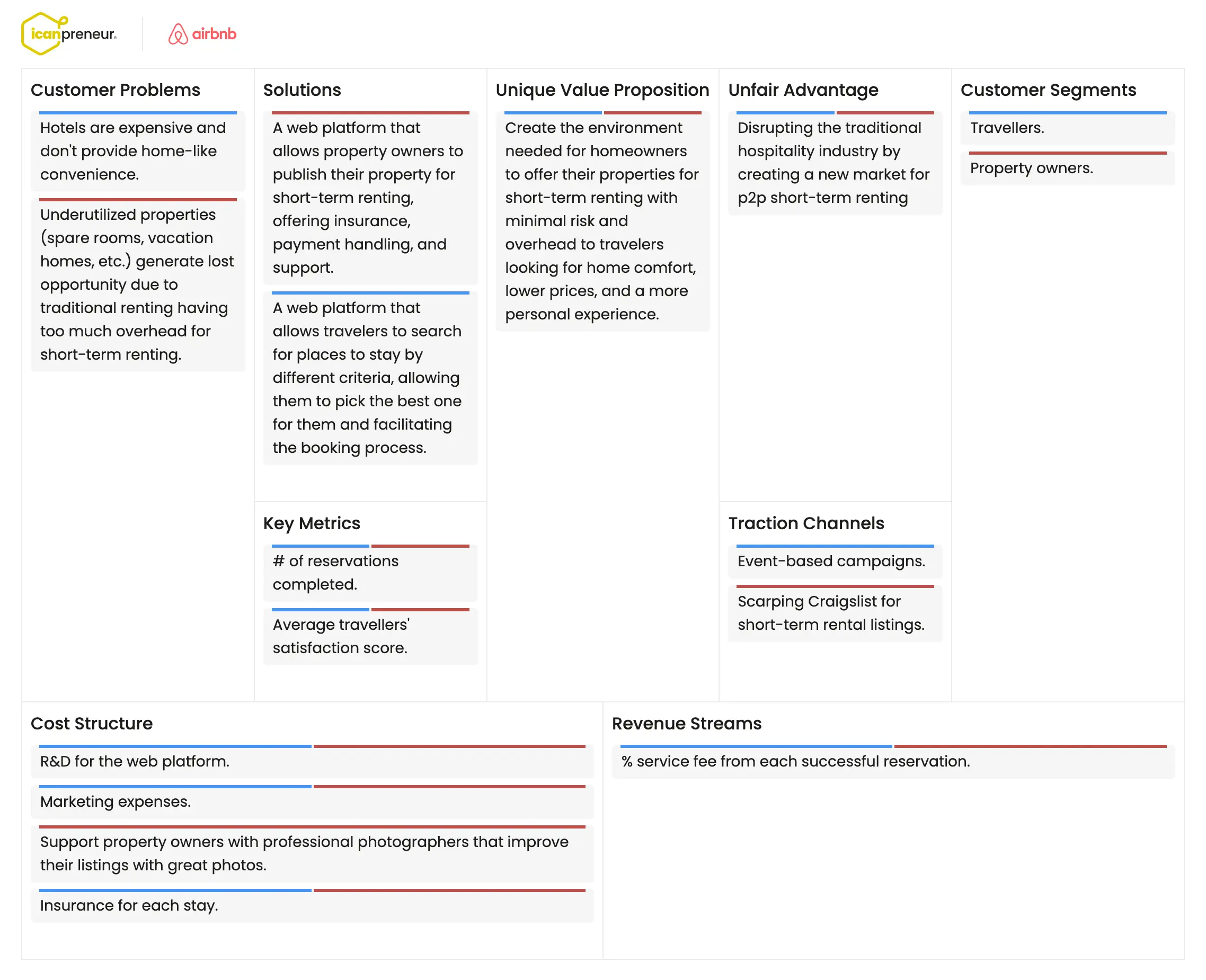
4. Facebook
Founded: 2004
Created by: Mark Zuckerberg, Eduardo Saverin, Andrew McCollum, Dustin Moskovitz, and Chris Hughes
Headquarters: Menlo Park, California, USA
Total funding: Approximately $2.3 billion (before IPO)
IPO: $16 billion in 2012
Stock ticker: META (formerly FB)
After its launch, Facebook quickly became one of the fastest-growing products ever. Unlike similar social platforms, Facebook betted a lot on the networking effect. They discovered that a user activates after inviting seven connections to their friends list. This became a key metric to focus on.
Creating a strong viral and referral effect led to solid growth with minimal customer acquisition costs. This created an exponential impact on Facebook’s development. The significant amount of venture capital attracted further supported the growth. Attracting such a big user base opened the opportunity for Facebook to evolve also as a social media. It’s now one of the main information channels for many people, expanding Facebook's market further.
This is what the canvas could look like if Mark and Eduardo wanted to make a Lean Canvas for Facebook at the beginning:
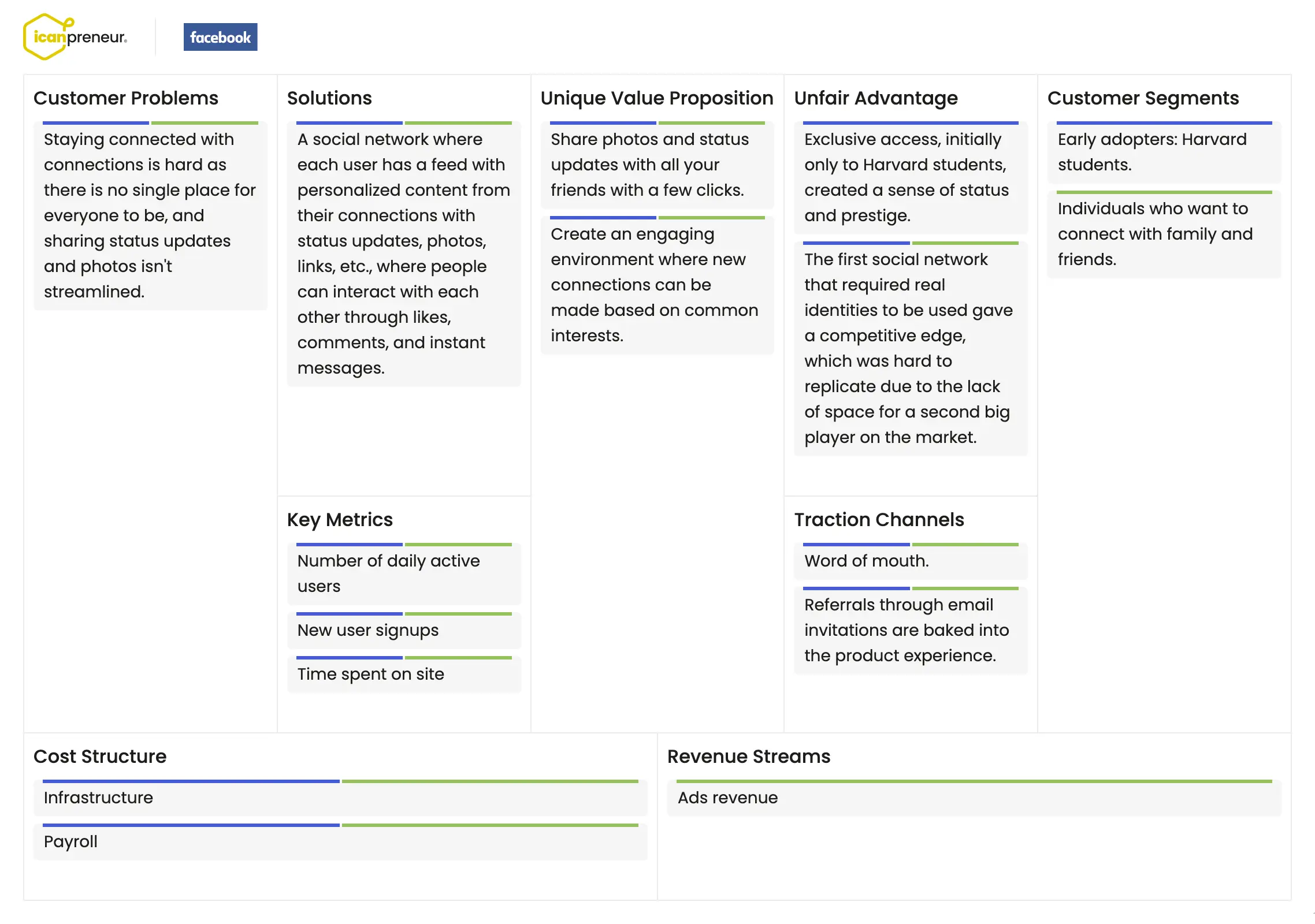
5. Amazon
Founded: 1994
Created by: Jeff Bezos
Headquarters: Seattle, Washington, USA
Total funding: Approximately $108 million (before IPO)
IPO: $54 million in 1997
Stock ticker: AMZN
Amazon’s business is vast, and capturing it in a single canvas is hard. For this example, we will focus on their Kindle product. When launching Kindle, Amazon had to overcome the traditional expectations that book readers have related to the “reading experience.” It's difficult to recreate the feeling of turning a page, feeling paper, and the smell of books with an electronic device.
The product needed to compensate by providing other advantages. For example, it allowed users to carry their entire library in their pocket and receive new books instantly. Amazon had the unfair advantage of a huge existing user base that they could directly approach with the new device. This helped them win over their competitors in the ebook readers space.
This is an example of a completed Lean Canvas for Kindle:

6. Apple
Founded: 1976
Created by: Steve Jobs, Steve Wozniak, and Ronald Wayne
Headquarters: Cupertino, California, USA
Total funding: $250,000 (before IPO)
IPO: $100 million in 1980
Stock ticker: AAPL
Apple’s first product was the personal computer, which many industry leaders said nobody will need. Yet, by focusing on what consumers needed, Steve Jobs and Steve Wozniak created the first personal computer at an accessible price for hobbyists.
Later on it became attractive to the mass market as opposed to targeting technical geeks. By putting consumers at the center of their products, Apple later released many products that pioneered new product categories - iPhone, Apple Watch, and iMac.
Let’s have a look at a possible canvas for Apple:
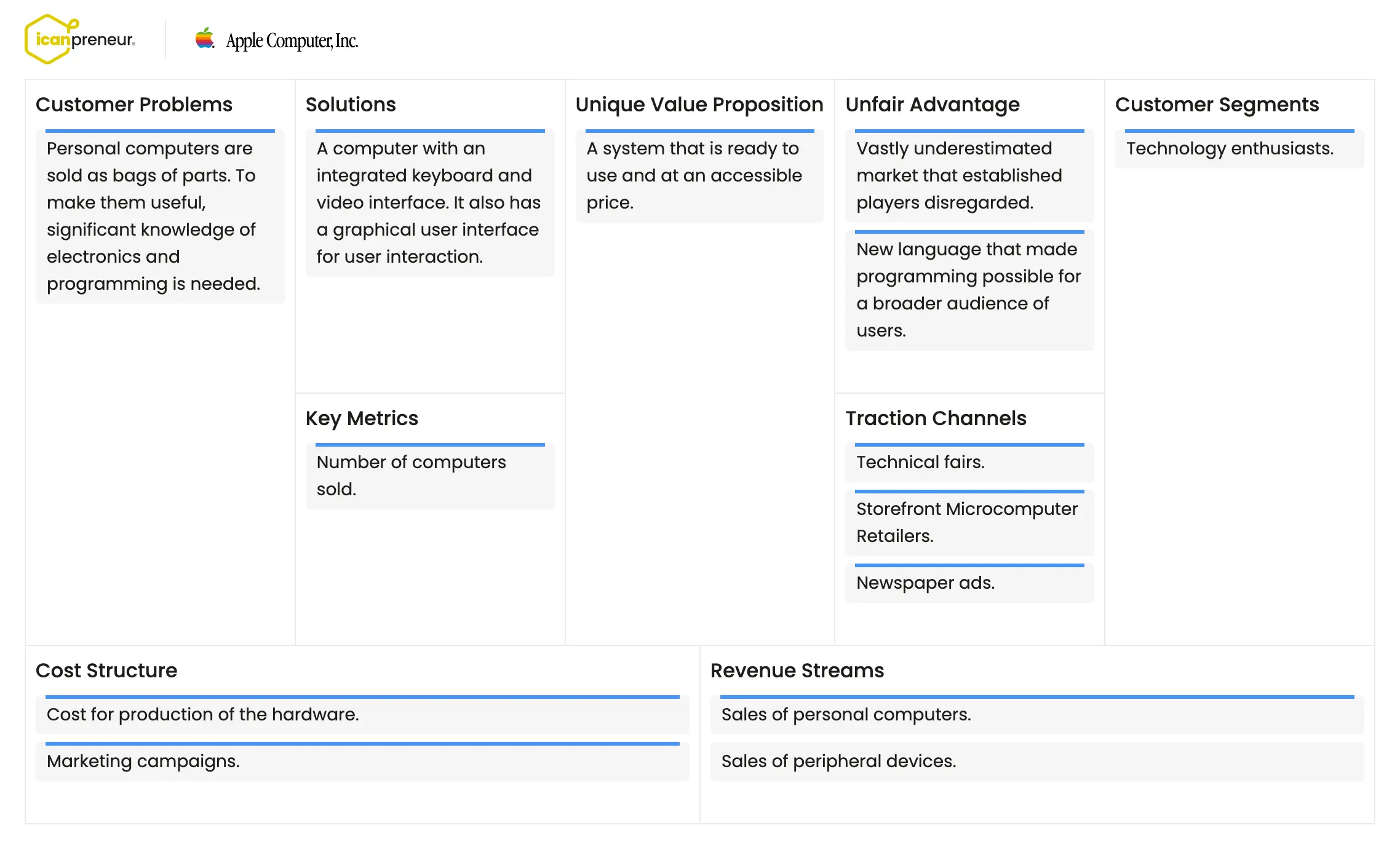
7. Tesla
Founded: 2003
Created by: Martin Eberhard, Marc Tarpenning
Headquarters: Palo Alto, California, USA
Total funding: Approximately $22 million (before IPO)
IPO: $226 million in 2010
Stock ticker: TSLA
Tesla has been the biggest disruptor in the automotive industry in recent decades. Its initial focus was to prove that electric cars can attract mass consumers and benefit the environment. Along the way, Tesla tackled many challenges like car range, charging infrastructure, and the planned obsolescence. Their innovation in these areas led to the creation of one of the most popular cars but also pushed competitors in this direction.
Tesla developed a remarkable strategy for attracting early adopters. Instead of making a car for the mass market, they made a fancy roadster that was expensive but popular with many. They turned this car into a status symbol. This created a positive image and spearheaded their marketing strategy later on.
To keep it simple, the canvas below doesn't include all of Tesla's products like Powerwall, Solar Roof, etc. The Lean Canvas example focuses only on their electric cars:

8. Skype
Founded: 2003
Created by: Niklas Zennström and Janus Friis
Headquarters: Luxembourg City, Luxembourg
Total funding: Approximately $18.8 million (before acquisition)
Acquisition: Acquired by eBay for $2.6 billion in 2005, then acquired by Microsoft for $8.5 billion in 2011
Current owner: Microsoft
Stock ticker: MSFT
Skype reimagined how people communicate globally by offering free voice and video calls over the Internet. This led to reduced costs for calling landlines and mobile phones. Their advantage was in the product's p2p architecture. The team had extensive experience in this area, previously working on the p2p file-sharing platform Kazaa. The p2p architecture allowed for superior calls without relying on expensive infrastructure.
Let’s have a look at how Skype’s canvas could’ve looked like in 2003:
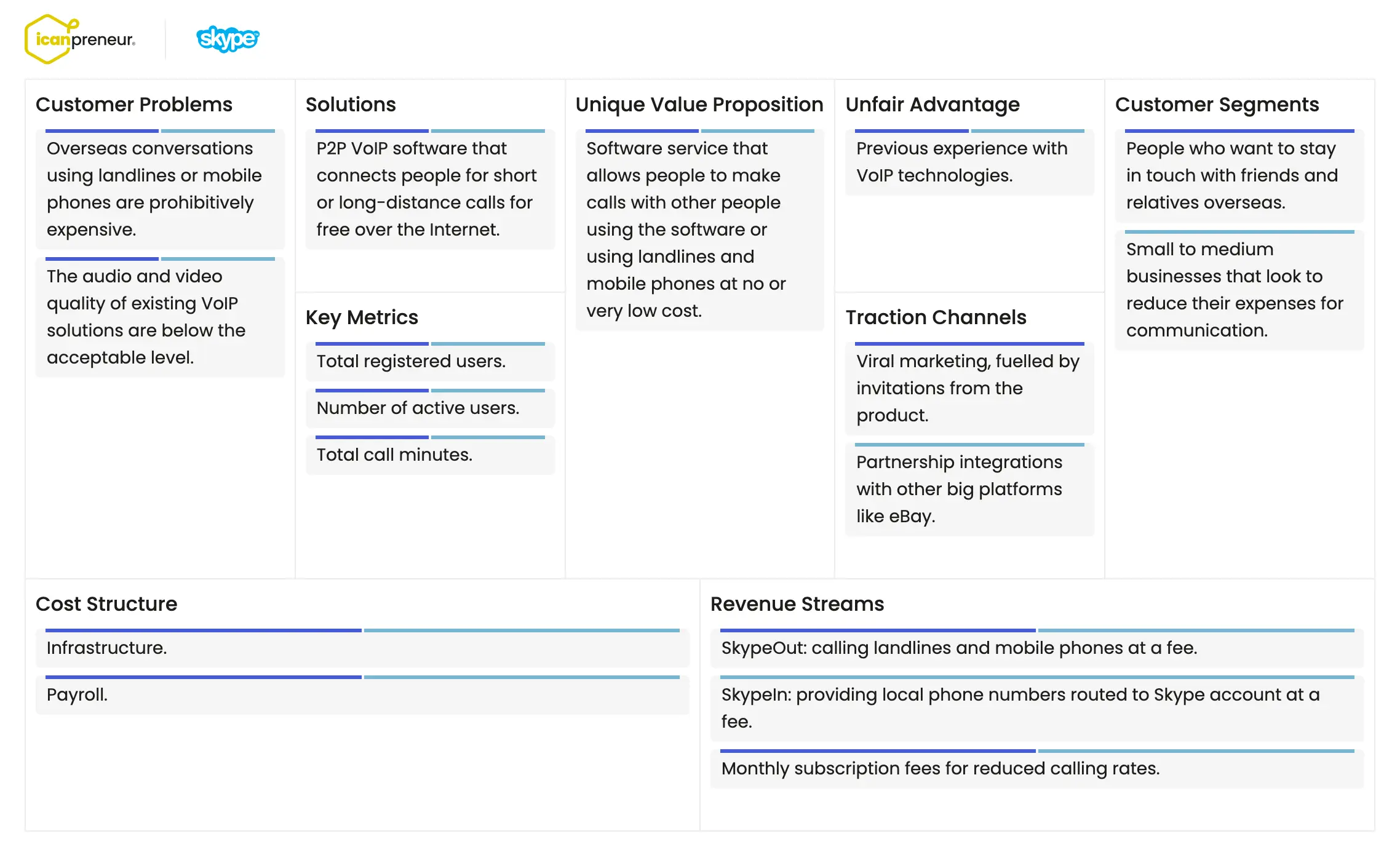
9. SpaceX
Founded: 2002
Created by: Elon Musk
Headquarters: Hawthorne, California, USA
Total funding: Approximately $6 billion
IPO: SpaceX isn’t a public company (it remains privately-held)
Stock ticker: N/A
SpaceX is a startup that is changing a slow, reliable, and bureaucratic industry. The company challenges the status quo using a new approach to rocket engineering. For example, they use cheaper components, reusable boosters, rockets, and significantly more aggressive launch targets and timelines. This has caused a significant reduction in launch costs compared to other groups. As a result, private companies now have more opportunities to access space.
Some of SpaceX’s achievements are:
- the first private company to reach ISS
- the first private company to bring crew to ISS
This is an example of how the Lean Canvas for SpaceX, would look like:
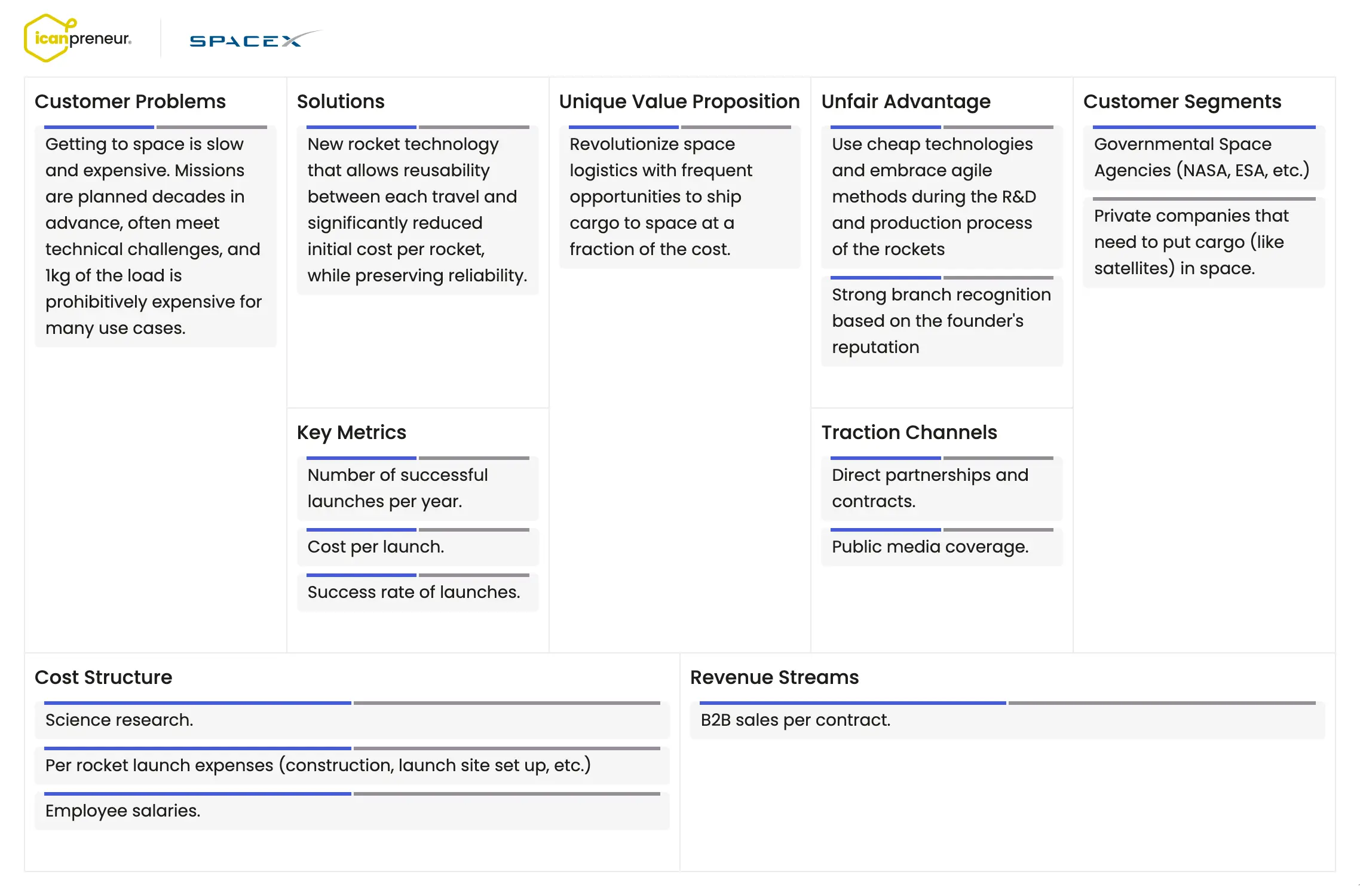
10. Slack
Founded: 2009
Created by: Stewart Butterfield, Eric Costello, Cal Henderson, and Serguei Mourachov
Headquarters: San Francisco, California, USA
Total funding: Approximately $1.2 billion (before IPO)
IPO: $19.5 billion in 2019
Stock ticker: WORK (acquired by Salesforce in 2020)
Slack is an interesting example of a product that results from a significant pivot. The company decided that their previous product would not bring the necessary profit, so they repurposed an internal tool as a product, and that’s how Slack came about.
By focusing on productive and enjoyable work communication as a problem space, Slack gave many teams a new way of operating. It allowed fast, efficient, and fun communication in the office or remotely. With the recent shift to remote and hybrid work, these types of products were upgraded from “nice to haves” to essential tools for the company's operation.
This is an example of Slack’s Lean Canvas:
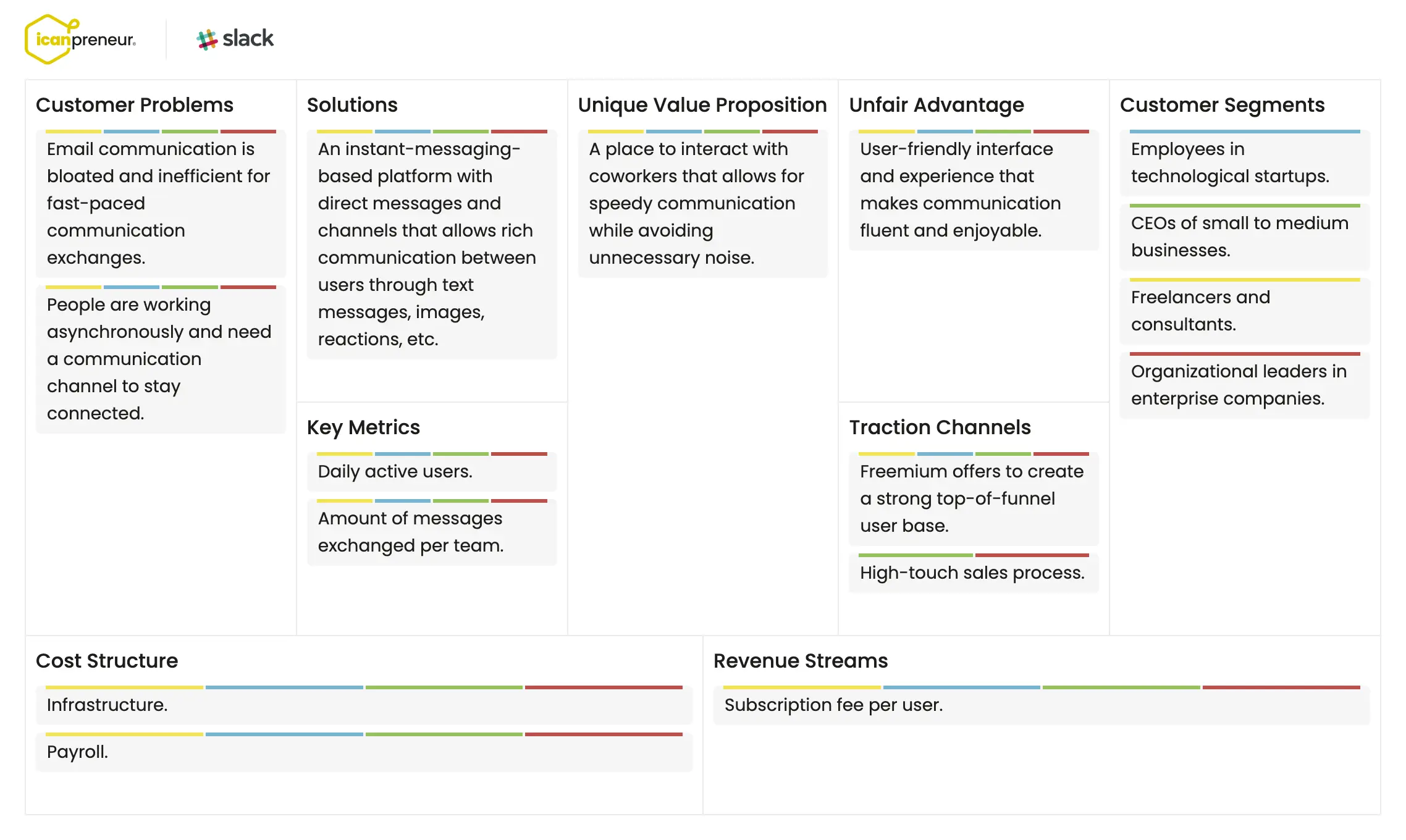
Wrap-Up
To summarize, we can extract a ton of learning by decomposing successful businesses using Lean Canvas. When building your own, things might get trickier, especially without prior experience. When creating your canvas model, most of what you put in it are assumptions and hypotheses.
Icanpreneur designed a journey to specifically guide and support entrepreneurs, and product builders through building their canvas. The platform provides all the needed guidelines, examples, and context to express your idea and its underlying assumptions. Later, you will be able to confirm these assumptions by talking to representatives of your customer segments.
Author
Product @ Icanpreneur. Coursera instructor, Guest Lecturer @ Product School and Telerik Academy. Angel Investor. Product manager with deep experience in building innovative products from zero to millions of users.
